HUMAN BODY VIBRATION EXPOSURE AND ITS MEASUREMENT
by
G.Rasmussen
ABSTRACT
Experimental data collected over the years, for
defining limits of vibration
exposure to human beings, have resulted in a set of
vibration criteria specified in ISO Standard 2631. In this article,
instrumentation requirements for evaluation of the responses of humans to
vibration according to these criteria are described, as well as some of the
pitfalls to be avoided during these
measurements.
Exposure limits for vibration transmitted
to the hands and arms of operators of vibrating tools have been suggested in
Draft Standard ISO/DIS 5349. A special hand adaptor
developed for the measurement of hand-arm vibration transmitted from the handle
of such tools is described in the article, and measurement results obtained
with it on a chip hammer are illustrated.
Introduction
The human body is both physically and
biologically a "system" of an extremely complex nature. When looked
upon as a mechanical system it can be considered to contain a number of linear
as well as non-linear "elements", and the mechanical properties are
quite different from person to person.
Biologically the
situation is by no means simpler, especially when psychological effects are
included. In considering the response of man to
vibrations and shocks it is necessary, however, to take into account both
mechanical and psychological effects.
Knowledge about
comfort and fatigue-decreased proficiency is based on statistical data
collected under practical and experimental conditions. Because experiments
with human beings are difficult, time consuming and in extreme cases unesthetical, much of the knowledge about damaging effects
has been obtained from experiments on animals. It is, of course, not always
possible to "scale" results obtained from animal experiments to
reactions expected from man, but nevertheless such experiments often result in
valuable information.
Considering first the human body as a
mechanical system it may, at low frequencies and low vibration levels, be
roughly approximated by a linear lumped parameter system of the type shown in
Fig. 1. One of the most important parts of this system with respect to
vibration and shock effect seems to be the part marked "thorax-abdomen
system". This is due to a distinct resonance effect occurring in the 3-6
Hz range as indicated on Fig. 2 and 3 and which makes efficient vibration
isolation of a sitting or standing person very difficult. A further resonance
effect
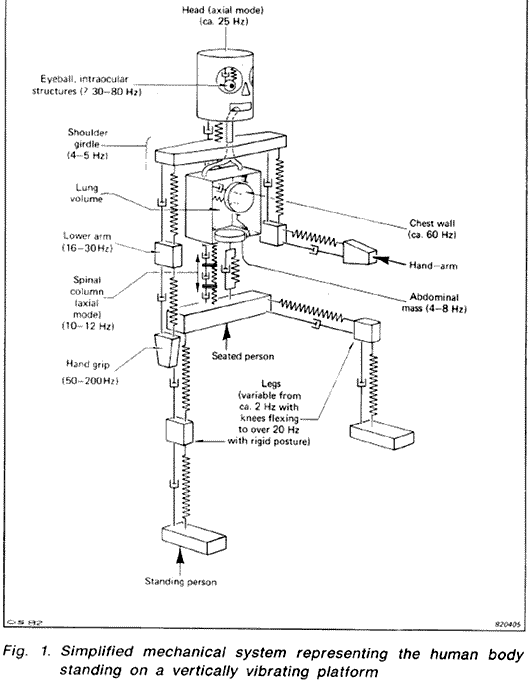
Fig. 1. Simplified mechanical system representing the human body standing on a vertically vibrating
platform
is found in the 20 to 30 Hz region and
is caused by the head-neckshoulder system, Fig. 3.
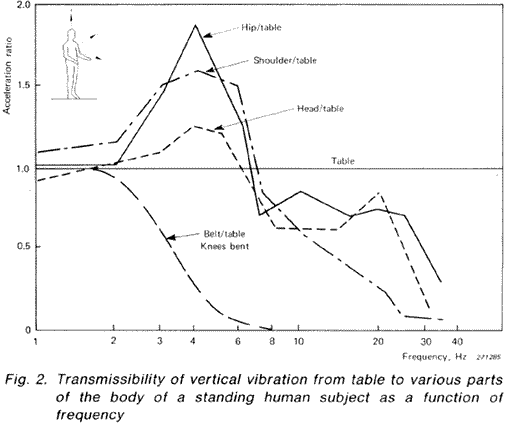
Fig. 2.
Also in the region 60
to 90 Hz disturbances are felt which suggest eyeball resonances, and a
resonance effect in the lower jaw-skull system has been found between 100 and
200 Hz.
Above 100 Hz, simple
lumped parameter models like that shown in Fig. 1 are not very useful. It is
then necessary to apply continuous structural analysis methods which become
very complex. By such methods, however, it has been shown that for the skull
itself, the fundamental mode of vibration seems to be in the region of 300 400
Hz with resonances for higher modes around 600 to 900 Hz. At still higher
frequencies use must be made of wave theory both in the form of shear waves and
of compressional waves (sound waves).
From a shock and
vibration point of view the low frequency range may be considered most
important. Some very interesting measurements have here been made by von Bekesy and concern the attenuation of vibration along the
human body. The results obtained at 50 Hz are reproduced in Fig. 4 and show
that the attenuation from foot to head is
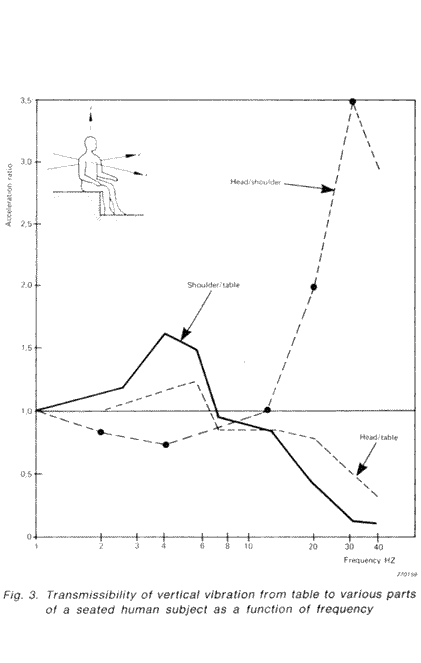 Fig. 3.
Fig. 3.
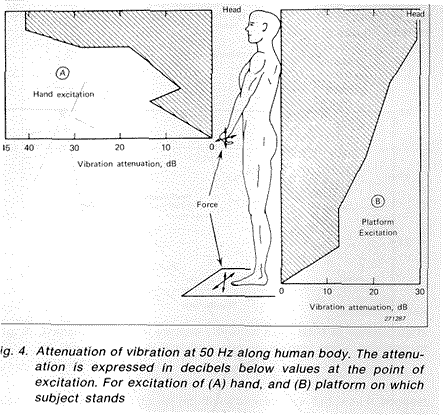
Fig. 4. Attenuation of vibration at 50 Hz along human body. The attenuation is expressed in decibels below values at the point of excitation. For excitation of (A) hand, and (B) platform on which subject stands
Vibration Exposure
Criteria
Apart from the mechanical responses
mentioned above, both physiological and psychological effects are observed.
Although these effects are rather complex and difficult to measure, it seems
that physiological results obtained from animal experiments also apply to man
to a certain extent. These experiments have been mostly concerned with changes
in food assimilation, muscular acitivity,
reproductive activity etc. as well as actual internal injury.
Psychological effects such as perception, discomfort, and pain, have recently been studied in some detail. Most of the studies have been carried out on vehicle drivers and aircraft pilots, whose ability to perform complex tasks under adverse environmental conditions, including vibration, is particularly important. The data available is therefore mainly for sitting or standing subjects. The recent ISO 2631 - 1978
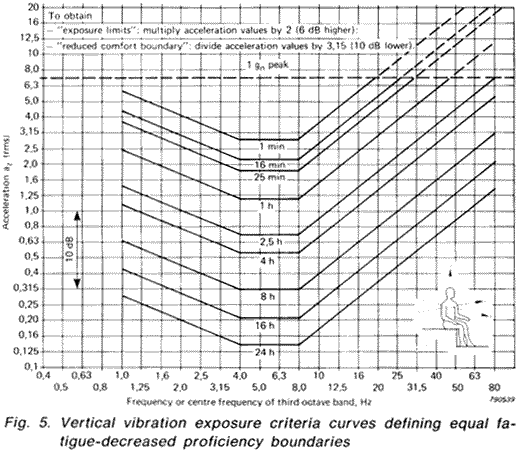
Fig. 5. Vertical vibration exposure criteria curves defining
equal fatigue-decreased proficiency boundaries
standard brings this data conveniently together
as a set of vibration criteria curves for vertical and lateral vibration over
the frequency range 1 to 80 Hz. These are shown in Figs.5 (vertical) and 6
(lateral), and apply to vibration transmitted to the torso of a standing or
sitting person in the axis system indicated.
Vibration at frequencies below 1 Hz
occurs in many forms of transport and produces effects, e.g. Kinetosis (motion sickness), which are completely
different in character from those produced at higher frequencies. These
effects cannot be simply related to the three parameters of the exciting
motion, intensity, duration, and frequency, as has been possible in the range
from 1 Hz to 80 Hz. In addition, human reaction to vibration below 1 Hz is
extremely variable and seems to depend on a large number of external factors
which have nothing to do with the motion, e.g. age, sex, vision, activity,
odours. Despite this variability and the limited amount of data available, an
attempt has been made to
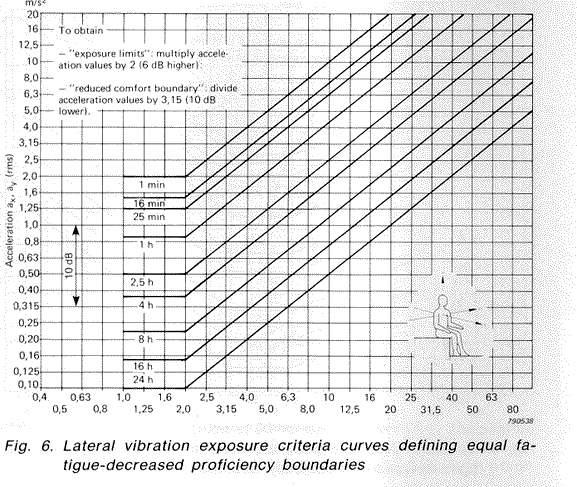
Fig. 6.
Above 80 Hz, the sensations and effects
are very dependent upon local conditions at the point of application, e.g. the
actual direction, position and area over which the vibration is transmitted,
and upon the damping at this point, e.g. due to clothing or footwear. These
external factors heavily influence the response of the skin and superficial
tissue chiefly affected by frequencies above 80 Hz. It is thus generally not
possible at present to state valid criteria outside the stated range, 1 Hz to
80 Hz.
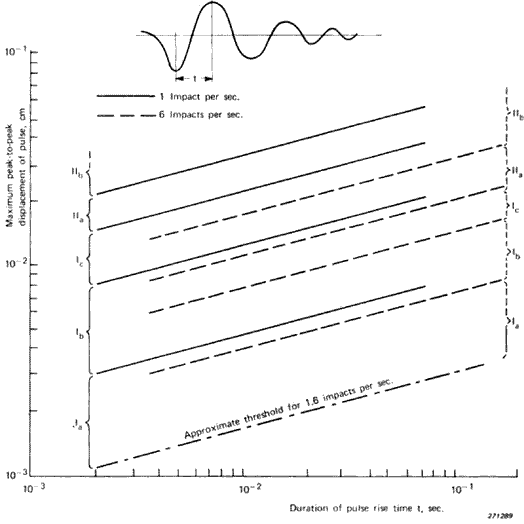
Fig. 7. Tolerance of human subjects in the standing or supine position to repetitive vertical impact
pulses representative of impacts from pile drivers, heavy tools, heavy traffic etc. Subjective reaction
is plotted as a function of the maximum displacement of the initial pulse and its rise time. The
numbers indicate the following reactions for the areas between the lines: I a, threshold of perception;
I b, for easy perception; I c, of strong perception, annoying; 11 a, very unpleasant, potential danger
for long exposures; II b, extremely unpleasant, definitely dangerous. The decay process of the
impact
pulses was
found
to be
of little practical
significance
The vibration levels indicated by the
curves in Figs.5 and 6 are given in terms of RMS
acceleration levels which produce equal fatigue-decreased proficiency.
Exceeding the exposure specified by the curves will, in most situations cause
noticeable fatigue and decreased job proficiency in most tasks. The degree of
task interference depends on the subject and the complexity of the task but the
curves indicate the general range for onset of such interference and the time
dependency observed.
An upper bound to
exposure considered acceptable (hazard to health as well as performance) is
taken to be twice as high as (6 dB above) the "fatigue-decreased
proficiency" boundary shown in Fig. 5 while the "reduced comfort
boundary" is assumed to be about one third of (10 dB below) the stated
levels.
These criteria are
presented as recommended guidelines or trend curves rather than firm boundaries
classifying quantitative biological or psychological limits. They are intended
only for situations involving healthy, normal people considered fit for normal
living routines and the stress of an average working day.
There are, as yet, no firm criteria for
purely angular vibration equivalent to those for purely translational
vibration as described above. In practice, angular motion (i.e. in yaw, roll
and pitch) whose centres of rotation lie at a distance from the point of
application to the body, can be adequately approximated by purely translatory motion. However, there is much current work
aimed at the eventual definition of criteria curves similar to those of Figs.5
and 6 for translatory vibration. Finally, Fig. 7
indicates the tolerance of human subjects to single shock acceleration pulses
of the type produced in the floor near drop forges or similar equipment
(results from a single study).
Symptoms for vibration
exposure at frequencies of 1 to 20 Hz are shown in Table 1. The frequency
ranges given are those where the symptoms are most predominant.
Symptoms Frequency
General
feeling of discomfort 4-9
Head symptoms 13-20
Lower jaw symptoms 6-8
Influence on speech 13-20
"Lump in the throat" 12-16
Chest pains 5-7
Abdominal
pains 4-10
Urge
to urinate 10-18
Increased
muscle tone 13-20
Influence on breathing movements 4-8
Muscle contractions 4-9
Table 1
Hand-arm Vibration
Exposure Criteria
Hand-arm vibration is the second large
problem area where transmission into the human body is concerned. It is,
however, rather different from whole-body vibration in the type of problems to
which it gives rise. Whereas vibration transmitted into the standing or seated
body normally gives rise to problems of a general nature, e.g. motion sickness,
discomfort, reduced-working efficiency, etc., vibration applied to the
hand-arm may, in addition, produce actual physical damage locally if the level
and exposure times are sufficiently high.
Vibration levels encountered in many
commonly used power tools are sufficiently high to cause damage when operated
for durations common in industry. Typical of these power tools are chipping
hammers, power grinders, hammer drills, and chain saws, found in widespread use
in the mining, construction, manufacturing and forestry industries. Vibration
may be transmitted into the body from a vibrating tool or hand-held workpiece via one or both arms simultaneously, causing, at
lower levels, discomfort and reduced working efficiency. At higher levels and
longer exposure periods, diseases affecting the blood vessels, joints and
circulation occur. Severe exposure leads to a progressive circulation disorder
in the part of the body suffering the highest level of vibration, usually the
fingers or hand where hand-held tools are concerned. This is variously known
as "dead hand", vibration-induced white finger, or Raynaud's disease. In extreme cases this leads to permanent
damage or gangrene. These diseases and their causes are currently being
extensively investigated both by medical and engineering researchers.
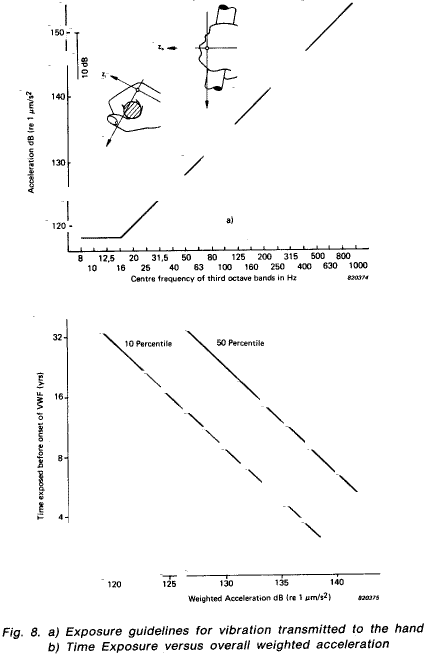
Fig. 8. a) Exposure guidelines for vibration transmitted to
the hand
b) Time Exposure versus overall weighted acceleration
A
very recent ISO draft proposal (5349) attempts to gather current knowledge into
a convenient form and to enable conclusions to be drawn about the damage risk
of practically measured vibration exposures. The suggested guideline levels are
shown in Fig. 8.a) and cover the frequency range from 8 Hz to 1 kHz. Although
exposure curves for both third octave and octave bands are presented, third
octaves are recommended as these are likely to be more stringent than octaves
when applied to the discrete frequency spectra often encountered in rotating
hand-held tools. It should be noted that the current trend is to recommend the
use of standardized 1/3 octave filter analysis especially in research.
Practical regulatory measurements are recently recommended to be carried out
using overall weighting for one figure reading as shown later in this article.
Overall weighted acceleration versus time exposure relationship is shown in
Fig.8.b) according to A.J.Brammer, NRC,
Most of the data used to derive the
curves were from pure sine or narrow band investigations and they are therefore
mainly applicable to that type of excitation. However, they may be
provisionally applied to repeated shock and other types of markedly
non-sinusoidal excitation, in which case a measure of the crest factor should
be determined.
Measurement of Human Vibration
Techniques for measuring vibration
exposure have for many years been less coordinated than desirable. The data
presented sometimes lack proper description of the instrumentation used to
acquire it and of the important instrumentation characteristics. The
descriptors used to characterize a signal are very important.
Possible descriptors, (Fig. 9) which may
all be seen used in the current literature, are:
positive peak negative peak maximum peak peak - peak
peak level (bandwidth limited)
max. r.m.s.
level (bandwidth and time constant required) Leq time
(bandwidth limited) (time required)
60 sec Leq
(bandwidth limited) max. r.m.s.
125 m/sec max. r.m.s. 1 sec
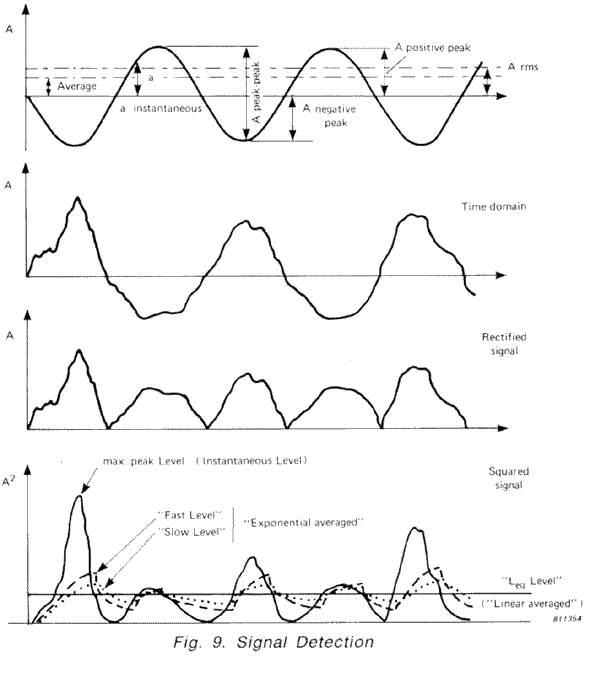
Fig. 9. Signal Detection
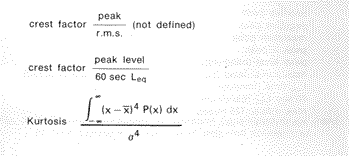

where Leq is in dB re. 10-6 ms-2 and a(t) is frequency weighted acceleration in ms-2.
Basically, vibration of man is measured in acceleration units m/s2 r.m.s. of a 1/3 octave frequency band (or possibly 1 octave bands for hand-arm vibration) over the frequency range of interest. The level of vibration may also be quoted in logarithmic units in terms of dB re 1 ìm/s2.
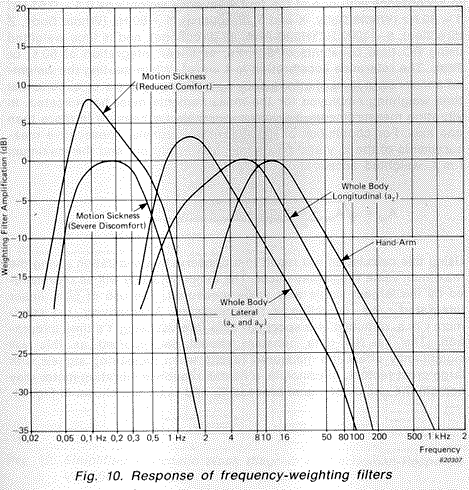
Fig. 10. Response of frequency-weighting
filters
This logarithmic representation of
amplitudes is particularly useful for quoting overall weighted levels, where
any resemblance with the m/s2 is lost due to the weighting. The standards for
Measurement of Human Vibration for instance ISO 2631 - 1978 take the
relationship between time versus level into
consideration. It thus gives exposure levels or doses in percent of permitted
vibration exposure for up to 24 hours. This makes the use of an overall
weighting important when single figure values are required for regulatory
purposes (see Fig. 10).
The weighted vibration level is expressed
in "Weighted m/s2" or in decibels (dB). The weighted vibration level
in decibels is 20 times the logarithm to the base ten of the ratio of a
weighted acceleration to the reference acceleration. Or mathematically the
acceleration is weighted in accordance with one of the four frequency
weightings 0,1 - 0,63 Hz, 1 - 80 Hz (Whole Body, X and Y directions), 1 - 80 Hz
(Whole Body, Z direction), 8 - 1000 Hz (Hand-Arm, all directions), and is
time-weighted using RC time constants of 8 - 1 s, or linear integration of 60
s, or Peak. The reference acceleration is 1
ìm/s2.
When quoting the weighted acceleration level, the frequency weighting and
linear or exponential time weighting employed for the measurements must be
indicated. In vibration measurements it is often desirable to measure in more
than one axis. For continuous or very repetitive signals, consecutive measurements
of the x, y and z axis may be carried out and the maximum r.m.s. weighted acceleration "AW" obtained
from
Aw
=[Awx2 + Awv2 + Awz2
Using this calculation will result in a
conservative evaluation giving the maximum value which may occur. The minimum
value will be represented by the largest single axis value measured. The use
of 60 s. linear integrated r.m.s.
detection is recommended. Alternatively, the maximum r.m.s. obtained in a specified time interval using 1
s time integration. The 1 s RC time constant should be reported as this will
significantly affect the measured results when measuring signals with large
crest factors. In principle, a human response vibration meter may contain the
choice of signal processing and read-out, shown in Fig. 11.
An instrument developed for measurements
according to these criteria, is the B & K Human-Response Vibration Meter
Type 2512, the block diagram of which is also shown in Fig. 12. For more
research-oriented work, it is often important to obtain more detailed
information about the frequency content of the vibration being measured using
filter techniques. The use of sequential switching requires a steady signal
over a rather long time and is therefore time consuming and sometimes not well
suited for the fluctuations we often see in vibrations influencing man.
Parallel analog filter bands have shortcomings in the
detector response and often misjudge rapidly varying signals.
FFT (Fast Fourier Transform) processors analyse blocks of data. It is important to realize that the block of data represents an approximation if a continuous, variable signal is analysed. Also the ultimate synthesization into 1/3 or 1/1 octaves often contains serious errors due to approximations, and the use of Hanning or other time-varying functions will make real-time data collection impossible. Accurate and noncomprising filter and detector techniques can be realized in the digital filter, which allows continuous data collection at very fast rates with no loss of integration time - linear or exponential - with a chosen confidence level.
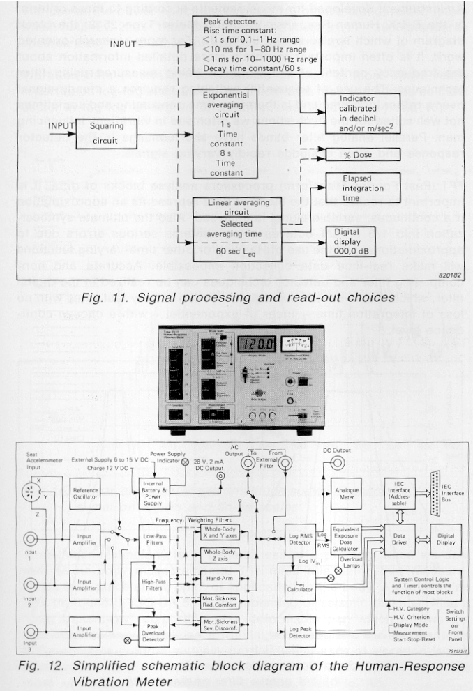
The use of the power spectrum through
1/3 octave standardized filters which fulfil IEC 225
- 1966, DIN 45 652 and ANSI S1.11 - 1966 standards ensures easy comparison of
spectra (see Fig. 13).
Vibration data in relation to influence
on man is most conveniently reported on log-log scales while technical data may
sometimes be most useful in log-log or log-lin or lin-lin scales. (See Figs.14 and 15).
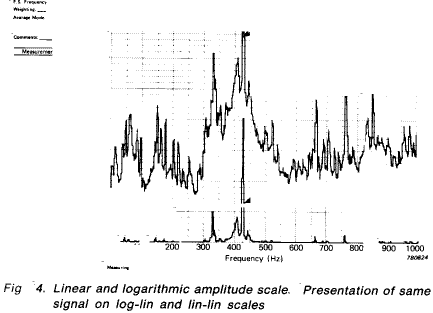
Fig. 14.
Transducer technology is in general less
of a problem when we deal with whole-body measurements. The
main rule being that measurements take place at the point of application to
the body. A useful guide may be found in ISO DP 5348 for mounting of
seismic pickups. Also a "seat transducer" consisting of a deformable
pad which follows the seat contour and containing a triaxial
accelerometer for simultaneous measurements in three mutually perpendicular
axes of vibration is well standardized (SAE Recommended Practice J 1013 (1973))
and will cover most whole-body measurement situations. (See Fig. 16).
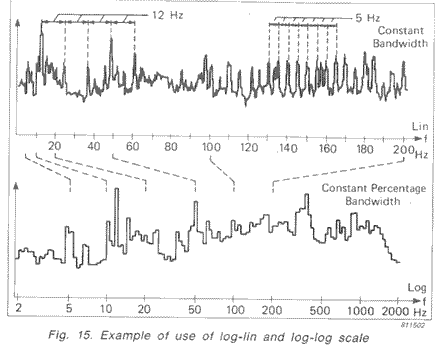
Fig, 15. Example of use of log-lin and log-log scale
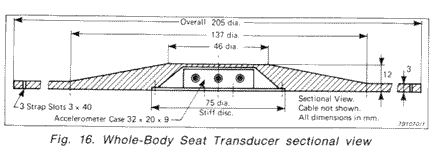
Measurements according to ISO 2631 and
DAM 1 as well as DAD 1 present no special instrumentation problems when proper
transducer technology is chosen. In particular, one should ensure minimum base
bending, cable whip, and temperature gradient sensitivity. This is even more
critical in carrying out measurements in the very low frequency range,
popularly referred to as "Motion Sickness", dealt with in ISO 2631
DAD 2.A four channel FM (Frequency Modulated) tape recorder is normally used
for simultaneous recording of three-axis vibration ensuring better than 3,5%
reproduction accuracy as also required for measurements on agricultural
vehicles, and enabling frequency transformation of 1:10 for analysis by
recording and replaying the signal at different speeds.
Hand-Arm Vibration Measurements
The measurement of Hand-Arm Vibration
presents some special problems both with regard to instrumentation and
transducer techniques.
Basically, 1/3 octave or 1/1 octave
filtered signal levels are quoted in the relevant Draft standard. However, it
is also common practice to use overall weighting filters for single number
readings.
The overall weighting method has become the primary method of quoting hand-arm vibration levels for regulatory purposes, industrial hygiene applications, and single number readings for labelling of hand tools. (See Fig. 17)
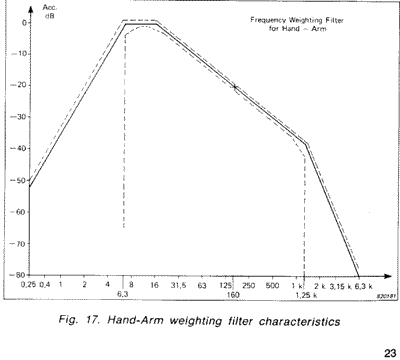
The 1/3 octave
analysis method is still to be preferred for gathering data in research and
practical engineering hand-arm vibration control work where high resolution of
the frequency spectrum is required. The most common error in quoting 1/3 or 1/1
octave levels is introduced using results obtained from FFT
analyzers. Harmonic signals or well defined random noise may very well be
treated by the calculation of a block sample with good approximation to the
continuous sampling technique, and the measurement of one single transient like
a hammer blow is also well suited for FFT
calculation. But series of transients or time varying signals like those most often
dealt with on percussive tools - chain saws - pedestal grinders etc., are very
difficult to assess without error even using averaging over many samples.
Errors in the power spectrum at high frequencies may easily be introduced
through limited block sample length.
Gathering data in the field for research purposes is most conveniently carried out using portable instrumentation with instrumentation tape recorders for subsequent laboratory examination.
Fig. 18.
[not shown]
Fully portable
instrumentation for field measurements
The introduction of errors due to the
very high acceleration levels experienced in idling percussive tools may cause
transducer problems like zero-shift or breakdown. These errors may be
eliminated using proper transducer adaptation techniques.
On transducer
application the following is quoted from the draft proposal ISO/DIS 5349:
"The vibration
pickup must be small and light enough for the specific application. Its
cross-axis sensitivity must be at least 20 dB below the sensitivity in the axis
to be measured.
The measurements in the three axes shall
be made at, or clearly related to, the surface of the hand where the energy
enters the body. If the hand of the person is, in direct contact with the
vibrating surface of the hand grip, the transducer should be fastened to the
vibrating structure. If a resilient element is being used between the hand and
the vibrating structure (for example, a cushioned handle), it is permissible to
use a suitable mount for the transducer (for example, a thin, suitably formed
metal sheet) placed between the hand and the surface of the resilient material.
In either case, care must be taken that the size, shape and mounting of the
transducer or of the special transducer support do not significantly influence
the transfer of vibration to the hand. Care must be taken when mounting the
transducer that the transfer function is flat up to 1500 Hz for all three directions.
Notes: 1. For
signals with a very high crest factor, for example those obtained from
percussive tools, special precautions must be taken to avoid overloading any
part of the system. Correct choice of the transducer is essential in this case.
It may be possible to use a mechanical filter with a suitable calibrated linear
transfer function to reduce the crest factor of these signals.
2. The proposed method for the case of a resilient element between the hand and the vibrating structure
is not satisfactory for all conditions, particularly in the case of thin cushions mainly affecting the transfer of
higher frequencies. In such cases it might be preferable to make the measurements with the transducer
rigidly attached to the handle or structure and to report separately the type, thickness, physical properties
and
estimated attenuation achieved by the cushioning
material.
Although characterization of the
vibration exposure currently uses the acceleration (velocity) transmitted to
the hand as the primary quantity, it is reasonable to assume that the
biological effects might depend to a large extent on the energy transmitted.
This energy depends on the coupling of the hand-arm system to the vibration
source and consequently on the grip pressure applied and the magnitude and
direction of the static force. Measurement of the energy transmitted to the
hand and of the tool application force is feasible and desirable for research
purposes and for future application to special tools, but is not yet proposed in
this International Standard. For the purpose of this International Standard,
the vibration exposures shall be reported for a grip pressure and static force represenative of the operational application of the tool or
coupling of the hand to the vibrating machinery. It must be realized that
changes in coupling can affect considerably the vibration exposure measured.".
In order to meet the requirements a
special handle has been developed at Bruel & Kjaer. It has been important to consider the following
points: a) The frequency response of the adaptor
should be linear from 5 Hz to above 1200 Hz.
b) The adaptor must represent a minimum load to the hand.
c) It should be easily adaptable and measure as close as possible to the standardized reference point
on both
right and left hand.
d) It should realistically reflect the
used grip strength.
e) It shall never underestimate the energy transmitted
to the hand from the handle.
An adaptor has been developed which
covers these requirements and has been tested in various practical situations.
The adaptor represents a compromise between close coupling to the handle of the
work piece and close coupling to the hand.
To be on the safe side in protecting the hand, the adaptor is designed to measure more closely the vibration of the handle than that experienced on the hand itself, if any difference exists. A drawing giving main dimensions is shown in Fig. 19.
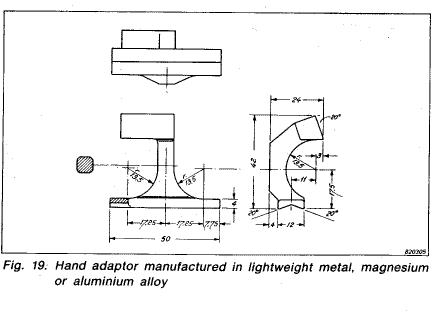
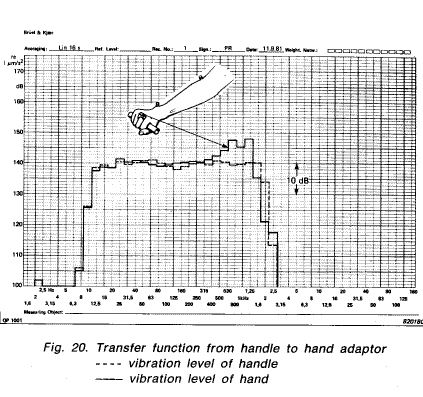
Fig. 20.
In Fig. 20 the response of a special vibrator with a test handle with built-in accelerometer is shown. The spectrum is equalized between 12 and 1200 Hz for a flat pink noise spectrum on the handle. The output from the adaptor applied by normal hand pressure is shown for the x direction. The transfer function, handle to adaptor, can thus be measured. The increase in level between 500 to 1000 Hz is caused by the compliance of the hand combined with the stiffness of the adaptor and the application force. The adaptor seems thus to overestimate the vibration level fed to the hand around 1000 Hz. However, a practical test on a pneumatic tool indicates an underestimation in relation to the usual reference point for pneumatic tools. In this case it is safe to assume that the adaptor gives a more realistic value than the reference accelerometer mounted on a mechanical filter on a welded stud in front of the handle.
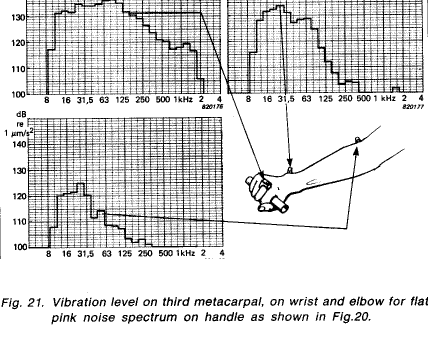
Fig. 21.
For comparison is shown the transfer
function from the handle to the head of the third metacarpal, which is the
standardized coordinate system reference position for the hand. (See Fig. 21).
The transfer function to the wrist (Fig. 21) and to the elbow is also shown.
Use of the proposed adaptor for hand-arm measurements is thus believed to be very safe, convenient, and to give reproducible results. Fig. 22 shows photographs of the actual test set-up for obtaining the hand-arm vibration responses shown in Figs. 20 and 21.
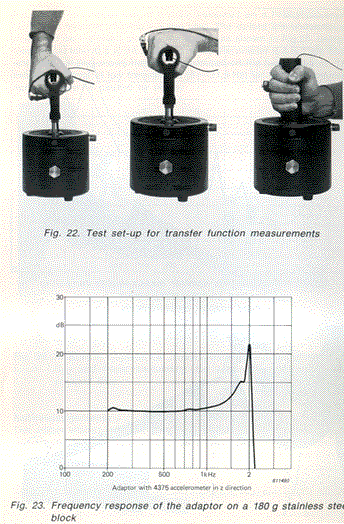
Fig. 23
shows the performance of the adaptor under
standardized response test conditions for acceleration pick-ups mounted on 180
gr. of stainless steel.
Fig. 22. Test set-up for
transfer function measurements
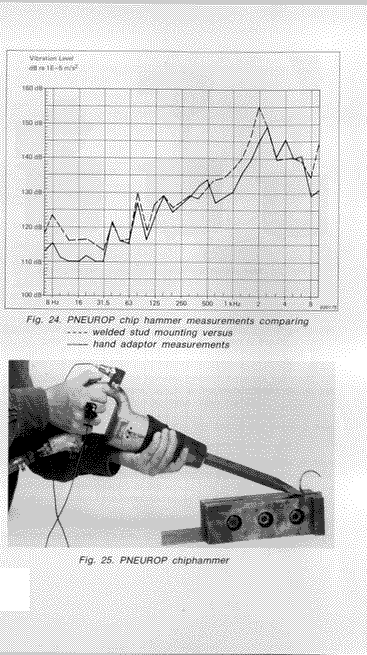
Fig. 24. PNEUROP chip
hammer measurements comparing
---- welded stud
mounting versus
--- hand adaptor measurements
Fig. 24 shows comparison of results measured on a PNEUROP round robin chip hammer shaving a 2 mm chip. The dotted line shows levels measured on a welded stud on the handle as shown in Fig.25, using a mechanical filter B & K UA 0559 and an accelerometer B & K Type 4369, while the full line shows the levels measured on the hand adaptor. The increase in level at low frequencies (8 -31,5 Hz) for the stud-mounted accelerometer is caused by noise.
Fig. 26.[not shown] PNEUROP chiphammer measurements using overall weighting Leq and Peak, calculating the exposure over a measured elapsed time
Acknowledgements The author wishes to thank Mr.J.R.Hassall for writing the introduction and the section on vibration exposure criteria.
end